Epoxy is the magic ingredient that has allowed many of us less than perfect joiners to create functionally sound boats, it corrects a multitude of sins and sticks like the proverbial, but like all magic potions has the potential to turn on and damage the user. The following cautionary tale is of Ian’s experience working with Epoxy. Having seen at first hand just how quickly Ian’s system responds to exposure I can only echo his concern that Home Boat Builders need to take great care with this stuff. Most of us are lucky enough to appear unaffected by Epoxy (I have had eight years exposure with no effect – so far) but I do wonder what might be going on unseen. – Chris Perkins
Click on picture for full size image
Epoxy – my story.
OK, before we start this is not aimed at anyone in particular but is simply aimed at you – the potential user of epoxy – and will illustrate what can happen if appropriate precautions are not taken. If you are a member of the yahoo forums you will find me as ianhurley20, why? It’s simply that I used to own an old Hurley 20′ yacht. It was in poor condition, cost a lot for a mooring, cost a lot to crane out of the water so I decided to build my own boat – but which one? There are a lot of different types and designs but I needed it to fit my garage and be trailerable to avoid mooring fees.
What type of construction then? I was taken by the relatively new stitch and tape construction method using Epoxy glues. The line in the instructions that said ‘dimensions and fits are not critical and gaps in construction are filled with epoxy filleting’ impressed me. I chose a Selway Fisher Lynx 14.
I sourced the marine ply from C F Andersons and Epoxy resins from UK Epoxy. Andersons provided BS 1088 marine ply at the best price I could find and UK Epoxy as the price seemed reasonable and Rob Hewitt was very helpful on the phone about my requirements. The build started on 31/5/07 and my first exposure to the glue on 8/6/07.
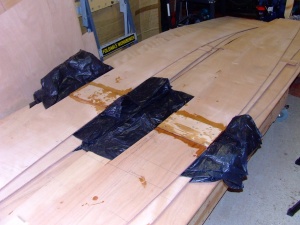
Butt jointed hull panels
I first butt joined the hull panels with epoxy. I was very unsure about the strength of the glue at this stage. I went on holiday and returned a week later to find amazingly strong joints. I was not working at this stage and my wife worked mornings until lunchtime so each day I would start at about 0830 and work up until lunchtime. The work progressed at a tremendous rate and I soon ran out of resin. I ordered more and continued with the build. At this time my main protection was wearing 3 pairs of vinyl gloves (if contaminated with glue the outer pair could easily be removed turning them inside out at the same time). Since my garage is not a big one I always had to work outside as the boat filled the garage. This provided ample ventilation.
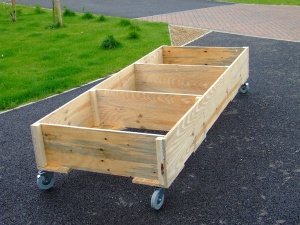
Moveable Trolley
I built a wheeled trolley on which to build the boat so it easily moved in and out of the garage.
On the 19/7/07 I had my first reaction. I had been working in the hull and had installed frame B, frame C and the two bilge cases the previous day.
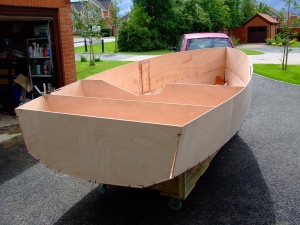
Basic Hull on the Trolley
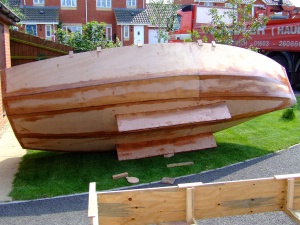
Bilge cases installed
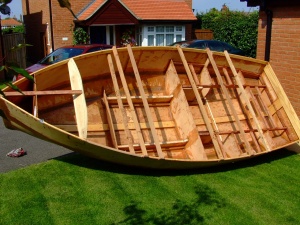
Frames B,C and Bilge cases installed
It involved lots of clambering in and out of the hull and a number of mixes of thickened epoxy glue. My face and arms went red and very itchy and my face also became swollen.
I took photos of all the safety labels and went to see my Doctor. He examined the photos of the labels and said ‘these mean nothing to me’!
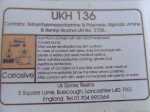
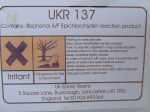
I was prescribed some antihistamine tablets and some hydrocortisone cream. I left the boat completely alone for a while. I got better. I decided to improve my protection. A filter mask, Tyvek suit and gauntlets as well as the vinyl gloves were now the minimum.
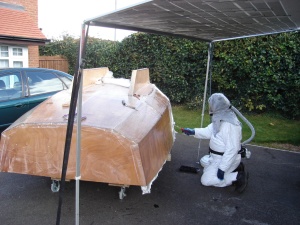
Upping the Protection
I did some sanding of the epoxied hull and reacted again. I contacted Rob who suggested a barrier cream – which made no improvement.
Whilst looking for barriers to the epoxy I found a nuclear/ chemical/biological protection suit on ebay. It came with a hood that had a blower system that kept a supply of filtered air coming into the hood. There were neoprene seals at the cuffs and neck and ankles with a fixed overboot for feet and a plastic glove for the hands. This together with gauntlets and several pairs of vinyl and nitrile gloves were now my barrier.
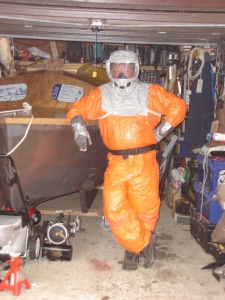
Even more protection
Working outside I now managed a period of reaction free time. BUT – the glue eventually got through again. Wherever possible I now tried to use a polyurethane glue such as Gorilla glue or Balcotan. At the end of October the weather made work on the boat difficult and I was now back at work so the boat rested in the garage until 5th May 08. By now I had only to sheath the upper hull and cockpit, sand and paint the boat. I took the greatest precautions I could. I had changed to MAS epoxy. With every pack that they send out is an information booklet. One of the articles in it details the dangers of epoxy and minimum precautions to take. I wish I had had this when I first started, I would probably have taken much greater precautions than I in fact did. MAS is the only supplier of epoxy I have come across that warns fully of the dangers and I feel that epoxy suppliers do not do enough to pass the warning on to customer, after all why should they? They have used the substance for years with no reaction! This time I immediately reacted. I gave away all of my stock of epoxy to another boatbuilder. But now I had a boat to sand and paint. I now discovered that the paint, a one pack polyurethane paint from Jotun, also caused a reaction. This was nowhere near as bad as epoxy but still to be avoided.
It was frustrating to get the boat so near but be unable to finish it.
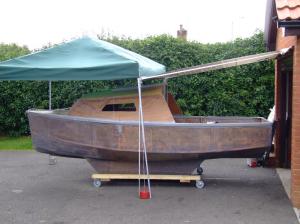
Sanding just about done
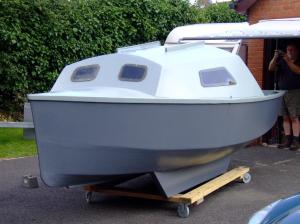
Then a volunteer came to my aid and spent almost a week sanding and painting the hull. I was then able to bolt fittings onto the hull and on 26/7/08 the boat was launched on the Norfolk broads.
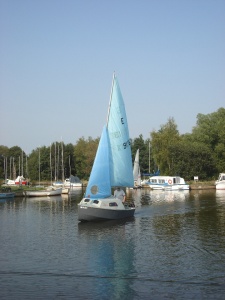
Launch Day – worth it all?
What next – well nothing, the boat has gained a nickname of ‘Never Again’. My sensible option might well have been to give up at the first reaction and you may say that stubborn determination is my main problem. What I would like all you prospective boatbuilders to do is to take considerable precautions. Latex gloves for example allow all the ‘nasties’ through and then trap them next to your skin so ideally use nitrile gloves that resist chemicals to a greater extent. A suitable mask and a suit that is not a paper one should also be worn. Don’t work indoors if at all possible. And if I ever build another boat it will be ‘Never Again II’ and will not use epoxy glues or polyurethane paints.
Ian Ruston












And don’t forget the dust from sanding is even worse!
By: ianhurley20 on September 24, 2012
at 9:33 am
Hello, Thankyou for this. I recently became sensitive to epoxy resin after only a few short weeks working with it.
I have been making carbon fibre body parts for Cars. my first reaction was pretty similar to yours, my face and hands flared up in itchy red blister that weeped. after a few days the skin split and ventually healed.
This then peeled off. Took about two weeks and lots of itching to fully heal.
My sensitivity has reached the point that i cannot go near the epoxy whilst it is uncured. The slightest whiff of the vapours causes a reaction
Treat this stuff with ultimate respect.
Oh and i read that it changes your dna…..
By: CArbon Fibre on June 2, 2012
at 1:02 am